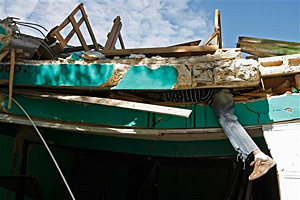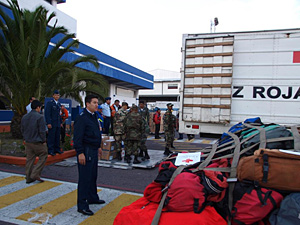“The President is alive but has nowhere to live.”
That was U.S. Secretary of State Hillary Clinton’s stark assessment of Haitian President Rene Preval’s situation Thursday and it applied to hundreds of thousands of Haitians who had survived the quake but faced immediate problems of surviving.
Government buildings in Haiti were severely damaged and the nation’s infrastructure, never solid, was in tatters. “There is no communications system,” said Clinton. “We are attempting to help set up a communications capability for the government."


The United Nations mission in Haiti, which had been promoting economic growth, was devastated, complicating relief efforts.
U.S. Military units are mobilizing under the U.S. Southern Command for the humanitarian mission, says Lt. Col. Lee Packnett, a Pentagon spokesman. The U.S. Army 2nd Brigade serves as the global response force and has been tapped to send a battalion from the 82nd Airborne Division for the mission. A company of 113 soldiers was loading up Thursday afternoon for a flight from Ft. Bragg, N.C., to be followed by about 800 more soldiers and specialists on Friday.
Maj. Bryan Fickel, a public affairs spokesman with the 82nd Airborne Division, said “we’re getting guys out the door as we speak…They are bringing in everything they have to bear on this.”
Fickel said the planning involves the U.S. Army Corps of Engineers and other logistics agencies and is in the middle of an intensive staffing and planning phase. “They will focus on the engineer equation and water and health type stuff,” he says. He adds that planners are “looking at some pretty large systems” for water purification that set up in the ocean. “They are moving that type of stuff now.”
He says the airport in Port-au-Prince is fit to receive planes up to the size of a C-17, which is large enough to transport a 70-ton M1 Abrams tank.
“The runway is completely intact and capable of receiving aircraft. The tower was damaged and is not operational; they are doing airport operations there, though.”
Behind the initial wave of 113 soldiers will follow a battalion centered around the 1-73 Cavalry, whose usual compliment of 450 to 600 people will be beefed up by about 200 “enablers,” probably including engineers. “One of the primary logistical concerns is getting engineering equipment in there. We are trying to get as much capability down there as we can. It is possible that we will send the entire 2nd Brigade Combat team.” The unit was last deployed 18 months ago during troop surge in Iraq.
The Seabees are gearing up to deploy an 85-person detachment from the Naval Mobile Construction Battalion 7, stationed in Gulfport, Miss. They expect to depart Friday, Jan. 15 or Saturday, according to Rob Mims, public affairs officer with the Naval Construction Battalion Center and 20th Seabee Readiness Group in Gulfport. Mims says the primary task will be debris removal to help aid workers gain access to ravaged areas; however, the scope could change over time as personnel have been told to prepare for six months in the country.
Mims says that more than 40 pieces of civil engineer support equipment will go with them, including dump trucks, excavators, loaders, graders, crawlers, humvees and transport trailers. The Haiti mission comes as many on the base are preparing for deployment to Afghanistan.
“It’s good that the Seabees are ready to go and can provide this humanitarian mission,” Mims said. “What they are doing is above and beyond what’s already scheduled.”
A contact in Costa Rica reported that airport authorities there, at Quiport, took advantage of an offer of a Hercules C130 from the Ecuadorian Air Force to dispatch 34 Army personnel to help. “Quiport sent in this plane this afternoon two paramedics, two medical doctors and 1½ tons of medicines, water, plastic plates, forks and knifes, gloves and masks, brooms, blankets, physiological serum and two-way radios all from our emergency stock, said Phlippe Baril, Quiport president and director general.
Water, sanitation transportation and electrical services also are said to be disabled, but disabled from a very low baseline.
According to Web sources, Haiti’s electrical grid had 270 MW of installed capacity in 2006, which is less than most U.S. baseload plants. Of that, a very large percentage is unavailable because of inadequate maintenance and old equipment. Only 12.5% of the population officially is covered for electricity. That doubles to 25% if illegal connections are included.
According to a 2000 World Bank report, 34% of Haitians had access to electricity at that time. The transmission and distribution losses, in Haiti were pegged at 53%, as compared with 16% for the entire Latin American and Caribbean Region and 9% for the world. In 2001, in another World Bank report, 24% of the nations road infrastructure was reported as being paved, vs. 27% for the region, 44% worldwide and 59% in the US.
According to a 2000 report from the World Health Organization, 46% of the population had access to improved water sources, as compared with 85% in the region and 82% worldwide.
Partners in Health, a Boston-based non-profit that has provided health care assistance in Haiti for more than 25 years, and which has been asked by the government to run a number of its major hospitals, is mounting a major relief effort with the help of US construction industry officials.
In a Jan. 14 post on its website, a PIH staffer who was able to reach Port-au-Prince after the quake reported aftershocks “and a tragedy more dire than we could have ever expected.” She adds that “there are still a handful of our colleagues unaccounted for—we continue to have every hope that it is due to lack of ability to communicate via telephone and the lack of electricity for computers, but we do not know.”
Shawmut Design & Construction, ranked no. 73 on ENR’s list of the Top 400 Contractors, with $872.3 million in 2008 building construction revenue, also based in Boston, was supporting PIH’s plan to build a new hospital in Haiti before the quake with donated time of its estimators, architects and engineers, says Jim Ansara, Shawmut chairman and founder and former CEO. He notes that the firm, which was sold to its employees in 2006, employs a large number of Haitians in Boston.
The company has been organizing transportation for trauma surgeons to fly to Haiti in a plane donated by one of its clients, who Ansara did not name. He says he is also working with Massport, the regional transportation agency, which is sending medical supplies that are set to leave early next week.
Ansara noted that one still-functioning hospital 70 miles from the stricken capital has “hundreds of people waiting in line” to have their injuries treated. Shawmut will also be deploying some personnel, beginning next week, to assist in building mobile army surgical unit (MASH) style medical facilities in the area.
Ansara says he has made a personal pledge to match up to $1 million for a new relief fund, called the Haiti Fund, which is being administered through the Boston Foundation. The relief effort is to be augmented by Shawmut employees and contributions from other area firms and others. Ansara says he hopes the effort will raise up to $5 million. About 25% of it will fund current relief efforts, but the remainder will be used to facilitate construction of needed infrastructure over the long term, he says.
Also planning a trip shortly to assist with building damage assessment work is Christopher Strock, a PhD construction student at Virginia Tech University, who recently supervised completion of a bridge project in Haiti and had been set to work on the new PIH hospital.
Other industry firms and organizations are deciding what to do.
Engineers Without Borders Executive Director Cathy Leslie says the organization had one team in Haiti before the quake from the University of Wisconsin, Madison, “and we have been in contact with them. They are not in Port-au-Prince but are in Bayonnais, where they felt the tremors, but no reports of damage to buildings or injuries to folks in the community.”
Bruce Buckley, Tom Armistead, Debra Rubin, Scott Lewis, Aileen Cho and Pam Hunter contributed to this report.



Post a comment to this article
Report Abusive Comment